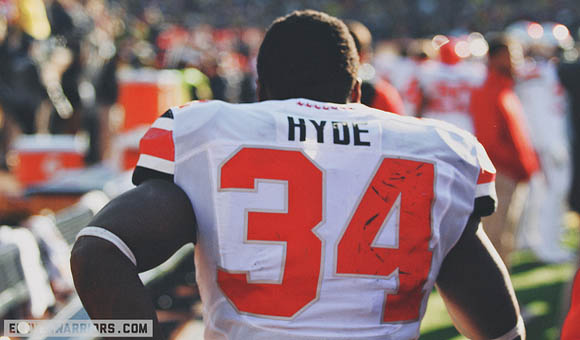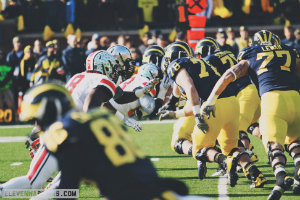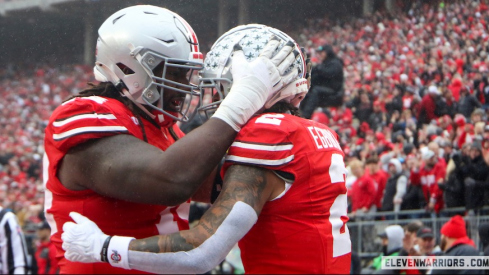
Well that was just like the statistics predicted, right? So the two images we definitely expected to see on our TV screens during The Game did happen: we saw Devin Gardner flat on his back, and we saw El Guapo flexing in the end zone.
However, almost everything else was different – Michigan's pass protection, Borges' gameplan, the Buckeye offensive gameplan – but maybe that really is just how rivalry games are.
All of our attempts at making data-driven predictions are at least loosely reliant on the "strategy" variable being held constant – especially when we use numbers at the team level. When many factors get altered at once, like starting personnel, new plays, and a coherent strategy, then it's much more difficult to make accurate predictions.
Or it's all totally random because this is college football. Oh well, go Buckeyes, 24-0, and on to the next one.
Keep Chuggin Along
Although Herman and Meyer eschewed the early quick perimeter passing game to set up the inside run game (and then play action passing), it might have been because Herman could have called 60 straight inside zone runs and had 65% running back efficiency and 40 points. That will not be the case next week against Michigan State.
The gameplan was almost neo-2012, focused on deep passes off of play action, Hyde inside, and Braxton running. Without the bevy of short perimeter passes, Braxton's completion percentage dipped below 50% (to 40%, but who's counting), but most efficiency metrics were unaffected:
| PPP | YPP | YPA | PppO | RED ZOne TD% | EX. Plays | |
|---|---|---|---|---|---|---|
| Ohio State Offense | .689 | 12.5 | 8.62 | 3.82 | 100% | 11 |
- In fact, Braxton's yards per attempt passing (8.9) were only .7 yards less than Devin Gardner's, despite the 318 total yardage difference. It wasn't Braxton's best day throwing the ball, but part of the low completion percentage was due to the strategy. Further, Gardner threw three times as many passes as Braxton, but with similar efficiency.
- With only 61 total plays, the Buckeyes had an extremely high points per play, especially with a fumble and an interception ending two drives. Only one three-and-out helped this number.
- This week I added points per possession (PPPO) to my list of metrics. PPPO is yet another measure of efficiency, with the most efficient offense obviously scoring seven points every time they touch the ball. This measure is nice because it values teams that score on long drives and teams that score on quick, explosive plays equally. 3.82 is the median PPPO for the Buckeyes this season. I'm interested to see what you all think, but PPPO seems to capture my perception of the team too, since it is based on possessions and points instead of plays and total yards.
- It's about time to discuss where Hyde's year ranks in terms of other legendary Buckeye running backs. With seven straight 100 yard performances, the most rushing yards ever against Michigan (226, breaking Beanie's 222), and a 74% RBSR, Guapo should be up there.
- Oh, and how about that offensive line? Even without senior Marcus Hall for most of the game, the line willed Hyde forward for at least four yards per snap in the second half. Maybe we can breathe a little easier for next year knowing that some of the backup offensive linemen are getting valuable playing time.
- I don't want to mention it, but Hyde also had his third carry for a loss yesterday (a -3 yard run at the beginning of the second half).
- The offense had one of its most explosive performances of the season with eleven plays of either a 15 yard rush or a 25 yard pass. Only two possessions that contained an explosive play failed to see the end zone.
- Braxton had a 50% RBSR, but most of his inefficient carries happened at the beginning of the game. In fact, four of his five second-half rushes were either explosive or for a touchdown. That's incredible.
These metrics paint a pretty good picture of the offense's performance yesterday. The offense was predicated on explosive plays through the air and on the ground, with few plays and high total yards. The points per possession numbers are extremely helpful here, however, moderating what looks like an otherwise completely dominating performance. The two
Nothing to See Here
The defense was another story entirely. Before listing the efficiency metrics, however, I think it's worth noting that Michigan passed 45 times yesterday. Anytime there are that many passes, there will be some that go for big yards even with a stingy defense.
| PPP | YPP | YPA | PPPO | Red zone TD % | Ex. Plays | PLPPO | |
|---|---|---|---|---|---|---|---|
| OSU Defense | .500 | 14.7 | 7.35 | 3.73 | 86% | 5 | 7.27 |
 This wasn't the matchup we predicted, though
This wasn't the matchup we predicted, though- Michigan was 6/7 for red zone touchdowns, with the failed red zone visit a turnover on downs. That's a hard number to be happy about. If the idea was to bend and not break (which is seldom the real goal of a defense), force Michigan to drive the length of the field, and play mistake-free football, then the strategy simply didn't work because of the Wolverines' success in the redzone.
- The defense allowed its longest rush on the season – a 38-yarder from Deveon Smith. That was one of just five explosive plays, but many more that were barely below the 15 and 25-yard thresholds.
- The Wolverines had 21 more plays than the Buckeyes and were efficient, with .5 points per play and roughly the same points per possession as the Buckeyes. In that regard, yesterday was eerily reminiscent of the 2006 #1-#2 matchup (thank goodness Urban is on our side now).
- I added another new metric this week in "plays per possession," or PLPPO in the chart. The idea is that the goal of every defensive series is either a three-and-out or a turnover, so a defense that always forces three-and-outs will have a PLPPO of three (let me know if you can think of a better abbreviation). The Buckeyes' 7.27 isn't great, as they allowed seven (!) trips to the redzone out of just eleven total possessions.
- Even though the overall efficiency metrics say "meh," I think it's important to highlight the good performances yesterday. Outside of Tyvis Powell's instant-classic interception, he played a solid game with six tackles and a fumble recovery. The other hero of the defense was Michael Bennett, who recorded five tackles, 1.5 TFLs, and 1.5 sacks. Oh, and you might have heard of Ryan Shazier, despite seemingly never being mentioned by the announcers. RDS ended with 14 tackles, 1.5 TFLs, and half a sack.
It's imperative that the Buckeyes get their third linebacker – whether it's Curtis Grant or Cam Williams – healthy and prepared for the Spartans next week. With Connor Cook throwing the ball decently and the MSU run game as strong as ever, the Buckeyes must force more punts and allow fewer trips to the red zone in order to have a shot at the national championship.
Regardless, the Buckeyes are 24-0, won The Game in one of the best editions of the rivalry yet, and are in a position to do something truly, truly special this season.

